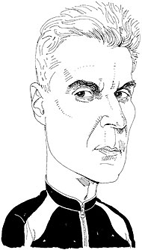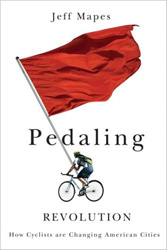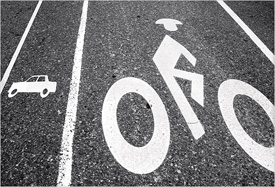Up Front: David Byrne
For the last three decades, the former Talking Heads frontman has done most of his urban traveling on two wheels, even when he’s out of town. “On my still ongoing tour, there are seven bikes traveling with us,” he said recently in an e-mail message. “Nothing fancy, no racing bikes. I always take a folding one.” On his blog at davidbyrne.com, Byrne chronicles his cycling adventures in unidyllic spots like Naples and Hong Kong (“the worst city for cyclists that I have encountered in the whole world”), as well as in some more bike-friendly territory. “Verona, Italy, was lovely to bike around,” he said, “as was Stuttgart — there’s a bike path along the river in that town with wine groves dotting the hillsides and outdoor restaurants. Some surprises too: Newcastle has a nice path along the river with Roman ruins, and a tunnel just for bicycles under the River Tyne.” In this week’s issue, Byrne reviews Jeff Mapes’s “Pedaling Revolution: How Cyclists Are Changing American Cities.” His own book “Bicycle Diaries” — about “cities and what makes them tick” — will be published in September. Bike Messenger: 'Pedaling Revolution - How Cyclists Are Changing American Cities' by Jeff Mapes
That said, the revolution isn’t here just yet. Hedge fund managers and General Motors executives aren’t riding to work (though don’t laugh, they will), and this book is not likely to reach beyond the already converted, which includes me, other cycling advocates, and people in the city-planning and transportation universe. But the book is useful — for those of us who occasionally find ourselves on the defensive, Mapes provides names, dates, facts and figures. He details how cities from Amsterdam to Paris to New York to Davis, Calif., have developed policies encouraging cycling in recent decades, and how other towns are just beginning to make way for bikes. He lays out in an easily digestible way a fair amount of material on trip patterns, traffic safety and air pollution. He quotes the relevant studies and shows how those studies have been either heeded or ignored. All this information is great ammunition for those of us who would like to see American cities become more bike-friendly but may be a tough sell for the people on the fence — the ones who’ve taken the occasional Sunday ride along a riverfront greenway or in a park, or have a vague feeling that they might possibly bike to work somehow someday. “Pedaling Revolution” is not all facts and figures. Mapes, a journalist who covers politics for The Oregonian, describes how he gained weight and started feeling a bit down when he was forced to exchange his 10-mile daily bike commute in Portland for a “super-sized, 50-mile” drive to the Legislature in Salem. He argues that cycling promotion can raise society’s level of general fitness, since people exercise more when it seems less like exercise and more like something mostly enjoyable that also performs a function, like getting to work. “Bike and walking advocates,” he writes, “have been rebranding their cause as ‘active transportation,’ which manages to come off as nonthreatening to your average couch-bound American while carrying a nice touch of gravitas as well.” Mapes finds the experience of riding around Portland — North America’s most bike-friendly city (though I think Vancouver is close) — so enjoyable that he takes as a given that it’s a positive thing, something that more communities should accommodate without question. But as he and I know, there’s a lot of opposition. The United States is as much a car culture as ever, even if the companies that helped make us that way are now in ruins. And governments and urban planners have all been in on the game, helping make the idea of cheap, effortless transportation and a car of one’s own a dream every American might aspire to. “Pedaling Revolution” is not about mountain biking the Moab sandstone formations in Utah or the network of bucolic paths that link some of the rural Massachusetts colleges; it’s not about racing, Lance Armstrong or what kind of spandex to buy. Nor is it about the various forms of extreme biking that have arisen lately: bike jousting on specially made high-horse bikes, BMX tricks or the arcane world of fixed-gear bikes, or fixies. For decades, Americans have too often seen cycling as a kind of macho extreme sport, which has actually done a lot to damage the cause of winning acceptance for biking as a legitimate form of transportation. If your association with bikes is guys in spandex narrowly missing you on the weekends or YouTube videos of kids flying over ramps on their clown-size bikes, you’re likely to think that bikes are for only the athletic and the risk-prone. Manufacturers in the United States have tended to make bikes that look like the two-wheeled equivalent of Hummers, with fat tires and stocky frames necessitating a hunched-over riding position that is downright unsafe for urban biking and commuting. But that’s been changing for at least a few years now. Whew. As Mapes points out, when more women begin riding, that will signal a big change in attitude, which will prompt further changes in the direction of safety and elegance. I can ride till my legs are sore and it won’t make riding any cooler, but when attractive women are seen sitting upright going about their city business on bikes day and night, the crowds will surely follow. A recent article in a British newspaper showed the pop singer Duffy on a pink bike. The model Agyness Deyn claims never to be without hers, and Courteney Cox reportedly presented Jennifer Aniston with a Chanel bike last year. Tabloid fodder does not a revolution make, but it’s a start. Toward the end of the book, Mapes gets into debates over bike lanes (are they really safer?), safety rules (should cyclists have to obey stop signs?) and traffic ideologies (should cyclists claim a full space in a lane, or stick to the edge of the road?) that only an obsessive or an advocate (hello!) is likely to be interested in. But the debates he presents may end up helping us all. Greenways, safer bike lanes, pedestrian zones and bike parking places will make our cities not only more comfortable and enjoyable, but also, as Janette Sadik-Khan, the New York City transportation commissioner, said recently, more economically competitive as well, as more of them become places where people with ideas and creative ambitions want to both live and work.
David Byrne’s most recent album is “Everything That Happens Will Happen Today.” His book “Bicycle Diaries” will be published in the fall. |





 If you’re walking around New York and you think you just saw David Byrne whiz by on a salvaged Austro Daimler bicycle, you probably did.
If you’re walking around New York and you think you just saw David Byrne whiz by on a salvaged Austro Daimler bicycle, you probably did. Full disclosure: I’ve ridden a bike around New York as my principal means of transport for 30 years, so I’m inclined to sympathize with the idea that a cycling revolution is upon us, and that it’s a good thing. Like Jeff Mapes, the author of “Pedaling Revolution: How Cyclists Are Changing American Cities,” I’ve watched the streets fill over the years with more and varied bike riders. It’s no longer just me, some food delivery guys and a posse of reckless messengers. Far from it.
Full disclosure: I’ve ridden a bike around New York as my principal means of transport for 30 years, so I’m inclined to sympathize with the idea that a cycling revolution is upon us, and that it’s a good thing. Like Jeff Mapes, the author of “Pedaling Revolution: How Cyclists Are Changing American Cities,” I’ve watched the streets fill over the years with more and varied bike riders. It’s no longer just me, some food delivery guys and a posse of reckless messengers. Far from it.